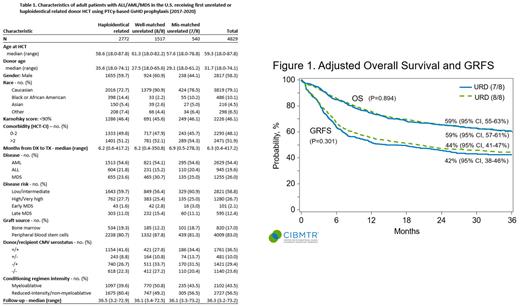Background: Post-transplant cyclophosphamide (PTCy) has become a standard of care for graft-versus-host disease (GvHD) prophylaxis in recipients of human leukocyte antigen (HLA)-matched and mismatched unrelated donor (MMUD) allografts, generating new opportunities for successful hematopoietic cell transplantation (HCT) regardless of patient ancestry. The National Marrow Donor Program (NMDP)-sponsored 15-MMUD study, which used PTCy-based GvHD prophylaxis (PMID 3390526), demonstrated encouraging overall survival (OS) in adult patients receiving MMUD bone marrow grafts matched at ≤7/8 HLA alleles. Currently, the follow-up ACCESS study (NCT04904588) will determine if similar outcomes can be achieved using MMUD peripheral blood stem cell allografts. As part of its 5-year strategic plan, the NMDP aims to determine the extent of differences in GvHD-free, relapse-free survival (GRFS) between 8/8 and 7/8 URD allografts using PTCy and seeks to develop approaches over time to close the presumed gap in URD outcomes.
Methods: The primary objective was to compare GRFS between 8/8 and 7/8 URD HCT using the Center for International Blood & Marrow Transplant Research (CIBMTR) database. After analyzing primary results, secondary objectives were added to compare GRFS, OS, and other clinical outcomes among 8/8 URD, 7/8 URD, and haploidentical-related donor (Haplo) HCT. The study included adult patients (age≥18y) with hematologic malignancies (ALL, AML, MDS) undergoing first URD or Haplo HCT between 2017-2020 using PTCy-based GvHD prophylaxis. Kaplan-Meier curves were used to estimate probability of GRFS and OS. Cox regression examined the independent effect of HLA match controlling for other clinical factors on outcomes referenced to 8/8 URD HCT. A priori clinically selected factors considered as possible confounders in the regression model included disease risk index, comorbidity risk, pre-HCT Karnofsky score, conditioning regimen intensity, graft source, donor/recipient CMV serostatus, year of HCT, donor/recipient age and race/ethnicity. Final models were stratified by factors violating the proportional hazards assumption. Factors were eliminated in a backwards fashion if p-values were >0.10 unless inclusion affected the hazard ratio (HR) of HLA match by more than 10%. Interactions were tested against a p-value of <0.01.
Results: Table 1 shows demographics for the three patient cohorts: Haplo (n=2772), 8/8 URD (N=1517), and 7/8 MMUD (N=540). Notable differences among the cohorts included: 8/8 URD recipients had younger, predominantly Caucasian donors and were more likely to receive myeloablative conditioning. Haplo recipients had more donor/recipient CMV seropositivity and received more reduced intensity conditioning. Otherwise patient characteristics were similar.
Contrary to our expectations, multivariable regression analysis (MVA) showed no significant differences in either GRFS or OS between recipients of 8/8 and 7/8 URD HCT at 1, 2 and 3-years post-HCT ( Figure 1). Outcomes, including relapse and NRM, between 8/8 and 7/8 URD HCT were similar irrespective of conditioning intensity. However, 8/8 URD HCT associated with lower two-year moderate/severe chronic GvHD than 7/8 URD [1.30 (1.00-1.68), p=0.049]. We next compared GRFS and OS among 8/8 and 7/8 URD and Haplo at 3y after HCT. On MVA, GRFS [HR 1.15 (1.04-1.26), p=0.005] and OS [HR 1.15 (1.03-1.29), p=0.013] were significantly better in 8/8 URD compared to Haplo HCT. Differences between 8/8 URD and Haplo appeared to be driven by significantly higher NRM [HR 1.46 (1.22-1.74), p<0.001)] and two-year moderate/severe chronic GvHD [HR 1.28 (1.07-1.54), p=0.007] in Haplo. No significant differences were seen in GRFS or OS at 3 years when comparing 7/8 URD to Haplo. Causes of death among donor types were similar with primary disease relapse/progression, infection and organ failure being the most frequent.
Conclusions: Use of PTCy-based GvHD prophylaxis seems to have resolved previously observed differences in GRFS and OS between 8/8 and 7/8 URD HCT. HCT using an 8/8 URD HCT, if available, continues to be the best option for patients lacking a matched sibling donor. Further studies comparing Haplo to 7/8 URD HCT are warranted, but will require larger numbers of 7/8 URD HCT. Both mismatched donor sources substantially increase access to HCT for patients regardless of their ancestry.
Disclosures
Auletta:Takeda: Membership on an entity's Board of Directors or advisory committees; National Marrow Donor Program: Current Employment; AscellaHealth: Membership on an entity's Board of Directors or advisory committees. Al Malki:NMDP: Membership on an entity's Board of Directors or advisory committees; Incyte: Membership on an entity's Board of Directors or advisory committees, Research Funding; Gilead: Membership on an entity's Board of Directors or advisory committees, Research Funding; NexImmune: Consultancy, Research Funding; T scan: Consultancy; Stemline Therapeutics: Membership on an entity's Board of Directors or advisory committees; Hasna Biopharma: Membership on an entity's Board of Directors or advisory committees; CareDx: Consultancy, Membership on an entity's Board of Directors or advisory committees. DeFor:National Marrow Donor Program: Current Employment. Shaffer:Gamida Cell: Consultancy, Research Funding; Hansa Biopharma: Consultancy. Modi:Morphosys, Seagen, AstraZeneca (spouse), Genentech (spouse): Consultancy; BeiGene: Speakers Bureau; Karyopharm, ADC Therapeutics, Genentech: Research Funding. Newcomb:Vertex: Current equity holder in publicly-traded company, Other: Spouse employment; Timedoc: Divested equity in a private or publicly-traded company in the past 24 months. Shpall:Celaid Therapeutics: Membership on an entity's Board of Directors or advisory committees; Navan: Membership on an entity's Board of Directors or advisory committees; Fibrobiologics: Membership on an entity's Board of Directors or advisory committees; Takeda: Other: License agreement; Affimed: Other: License agreement; Adaptimmune: Membership on an entity's Board of Directors or advisory committees; Axio: Membership on an entity's Board of Directors or advisory committees; Syena: Other: License agreement; NY Blood Center: Membership on an entity's Board of Directors or advisory committees. Stefanski:National Marrow Donor Program: Current Employment. Jimenez Jimenez:Abbvie: Research Funding.


This feature is available to Subscribers Only
Sign In or Create an Account Close Modal